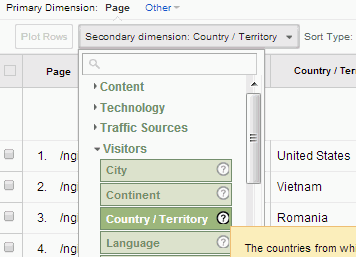Secondary Dimension in Google Analytics: Finest Practices and Tips
Secondary Dimension in Google Analytics: Finest Practices and Tips
Blog Article
Maximize Coverage Precision With Additional Measurement in Google Analytics
Comprehending how to make best use of reporting accuracy with second dimensions in Google Analytics can dramatically enhance the deepness of insights acquired from data analysis. By including secondary dimensions purposefully, marketers can discover surprise patterns and correlations that might not be immediately obvious when examining primary metrics alone. This nuanced method allows an extra comprehensive understanding of individual actions and project efficiency, paving the way for more targeted and efficient decision-making. The application of additional dimensions holds the vital to opening a wealth of valuable information that can transform the performance of electronic marketing strategies.
Understanding Second Dimensions in Google Analytics
To improve information analysis and gain deeper understandings into user habits, understanding secondary measurements in Google Analytics is vital. Secondary measurements allow customers to segment and further explore data past the main measurement picked. By integrating secondary measurements, experts can fine-tune their reports to reveal even more comprehensive details regarding customer communications on a website. For example, while the main dimension might present the overall number of page views, adding a second dimension such as 'source/medium' can supply understandings into where the traffic stemmed from. This extra layer of details makes it possible for marketing experts to examine the effectiveness of different advertising projects or channels in driving traffic to the internet site.
Additionally, recognizing second measurements is essential for creating more personalized reports tailored to details company objectives. By choosing the best combination of second and main measurements, experts can discover patterns, trends, and correlations that could or else remain concealed. This nuanced approach to data evaluation equips organizations to make educated decisions based upon a detailed understanding of individual habits throughout different measurements.

Just How to Use Second Dimensions
When leveraging additional dimensions in Google Analytics, the functional application entails picking specific information parameters to further refine insights beyond the main dimension's range. To use second dimensions efficiently, start by accessing the report or dataset where you wish to delve much deeper right into the information. Keep in mind that secondary measurements assist offer context and granularity to your main dimension data, allowing you to extract even more meaningful and actionable understandings from your Google Analytics reports.
Leveraging Second Measurements for Insights
Using secondary dimensions in Google Analytics permits a much more detailed evaluation of information, using valuable understandings past the key dimension's extent. By leveraging secondary dimensions, individuals can dive deeper into the efficiency metrics of their web site or application, uncovering concealed patterns and trends that may not be instantly apparent when only looking at main dimensions.
One key advantage of using secondary measurements is the ability to sector and filter information more precisely. This can assist online marketers and analysts much better understand the behavior of certain user sections, such as brand-new visitors versus returning visitors, or web traffic coming from different geographic areas.
Furthermore, additional dimensions enable customers to contrast and comparison various information points within the same record, supplying a more alternative sight of performance (Secondary Dimension in Google Analytics). Coupling the key measurement of landing pages with second dimensions like tools or demographics can expose which web pages are most effective in involving customers on different devices or from various demographic groups.
In significance, leveraging second dimensions in Google Analytics encourages additional info individuals to draw out richer understandings from their information, bring about even more educated decision-making and ultimately, boosted performance.
Ideal Practices for Secondary Dimensions
When examining data in Google Analytics, including additional dimensions efficiently improves the depth of understandings stemmed from the key metrics. To make one of the most out of second measurements, it is crucial to abide by best practices that guarantee significant and exact coverage. To start with, it is important to select secondary dimensions that align with the main metric you are analyzing. Choosing relevant additional measurements helps in supplying context and a more clear understanding of the information being examined.
In addition, it is suggested to limit the number of additional measurements used in a solitary record to avoid frustrating the analysis with excessive details. Concentrating on a few crucial secondary measurements at a time can bring about more concentrated and actionable understandings. In addition, consider try out various mixes of key and secondary dimensions to discover one-of-a-kind patterns and patterns that may not be apparent when considering the information in seclusion.
Advanced Evaluation Methods With Additional Dimensions
Discovering detailed data relationships via the critical application of secondary measurements can reveal nuanced insights that raise the deepness of evaluation in Google Analytics. By integrating additional measurements with main information collections, innovative evaluation techniques can be employed to remove important information.
Moreover, additional dimensions can boost the analysis of conversion courses by giving extra context. Comprehending the various touchpoints a user interacts with before transforming can be crucial in enhancing the consumer trip - Secondary Dimension in Google Analytics. By making use of additional measurements to explore specifics such as traffic resources or devices made use of, online marketers can tailor techniques to target high-converting channels properly
Verdict

To boost information evaluation and gain deeper insights into user behavior, recognizing secondary measurements in Google Analytics is vital - Secondary Dimension in Google Analytics. Additional dimensions enable users to sector and further dissect data past the key dimension selected. While the main measurement may show the overall number of web page sights, including a second measurement such as 'source/medium' can give insights right into where the imp source traffic stemmed from.When leveraging additional dimensions in Google Analytics, the practical application includes choosing particular data parameters to more improve understandings beyond the key dimension's extent. Remember that additional dimensions help provide context and granularity to your key measurement data, allowing you to remove even more significant and actionable understandings from your Google Analytics records
Report this page